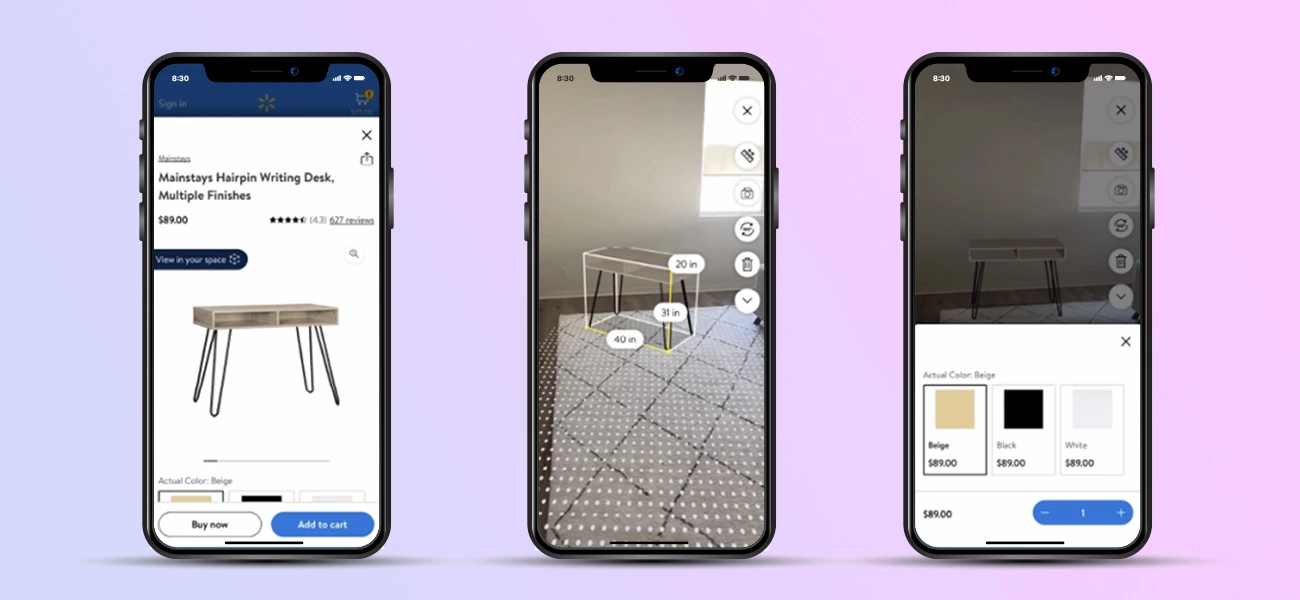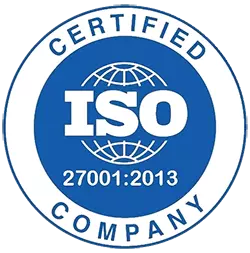Augmented Reality Marketing: The Future of Interactive Experiences

Augmented reality marketing has a vital role to play in the modern business world. With AR, customers can view and interact with a product as though it were right before them. It enhances a customer’s buying experience and brand loyalty. With advancements in AR technology, customers’ expectations are only increasing, and AR marketing seems to be the way forward.
So, let’s learn a little more about AR marketing to help you figure out the best way to use this technology to boost your business.
What is AR Marketing?
AR marketing integrates augmented reality into your marketing campaigns. It is used to enhance the customer experience, increase their satisfaction, shape their behavior, and boost earnings. But what is AR? It is a technology that blends 3D models with the real world environment. The digital models are overlaid on the physical environment to enhance the viewing experience.
The intention of using Augmented Reality in marketing is to create unique customer experiences and give them convenient in-store shopping. AR doesn't simply make products look more realistic and overlap within their physical environment . It also allows customers to "try" a product before buying it. This way, a customer feels more confident in their purchase decision.
Example: How Amazon Uses Augmented Reality in Marketing
Let’s say a customer wants to purchase a sofa from the Amazon app. The app uses Virtual configurator to allow customers to view products in AR before purchasing. It allows them to see a sofa, for example, in their living room with the "View in your room" option.
The customer can point their phone’s camera at any spot in their living room, and the app will overlay a 3D-rendered sofa on the space. They can move around and see where the sofa will be best; or if it will fit. They can also view different versions of the sofa to see which matches the room decor.
By doing this, the customer can get a feel for how the sofa will fit into their living space. This option allows customers to better understand what they are about to buy, more effectively than mere 2D pictures can. If the customer enjoys the buying experience and is happy with their purchase, they will spread the word. This adds to the company’s product promotions through word of mouth marketing.
Benefits of AR marketing
AR marketing offers businesses many benefits, helps boost sales and brand value. It also creates unique, semi-immersive shopping experiences for prospects. Now, let's look at its benefits in detail.
-
Increases Engagement
One of the main benefits of AR marketing is that it increases customer engagement. It lets customers view a product in a real-world setting as if it were before their eyes. Users can rotate and zoom in on the product to check all its details. Before buying, they can also check to see if the item will fit in their room or on themselves. It creates a more engaging and interactive experience for customers.
-
Improves Customer Experience
3D models in an AR environment can help users perfectly visualize a product. Consumers can customize the product's colors, textures, and other features in detail. Interaction with the product online helps them form accurate expectations by configuring the products as per their preferences. It also makes them more confident about the product they are about to buy. If a customer is happy, from seeing the product to receiving it, their overall shopping experience improves. This in turn, improves the product's eCommerce value.
-
Enhances Brand Awareness
AR marketing campaigns help build brand awareness by creating unique interactive experiences. Many brands use AR in marketing campaigns to stand out from the competition. It also helps them make a lasting impression on people's minds. Such campaigns encourage people to engage and interact with the brand, turning them into customers.
-
Increases Sales
AR-based ads improve your chances of converting customers more than conventional marketing does. Many people own one or more gadgets that allow them to view AR features. Incorporating augmented reality into advertising makes the product ads more engaging. They can help customers visualize and understand what to expect when they buy a product. It leads to fewer returns and better ROI.
-
Gives You a Competitive Advantage
Most markets are saturated with flat, 2D-based ads, and the competition in them is high. It will be harder to distinguish yourself from the competition if everything you do is the same. AR can help you stand out from the crowd and attract customers. Although not new, AR still has a certain novelty, making it more attractive to the target audience. Be creative and use AR in different ways in your product marketing to gain a competitive edge.
How Can You Use AR to Step Up Your Business?
AR is primarily used in the eCommerce, gaming, healthcare, industrial, and retail industries. The technology is gaining much interest as innovators find new and unique ways to implement it in business. Here are some of the ways in which you can use AR to boost your business:
-
Let Customers “Try” Before They Buy
Usually, customers want to feel a product before purchasing it. With AR, customers can “try” clothing, furniture, cosmetics, and more without going to the store. That is why there is an increase in the use of AR in the furniture industry.
A great example of this is the IKEA app. With the IKEA Place app, customers can experience furniture shopping from the comfort of their homes. Like all AR applications, IKEA place uses 3D models to help customers pick furniture of the right size, design, and functionality.
-
Augment Customer Service with Virtual Assistance
Augmented reality allows you to add a digital component to your products. With this feature, you can offer product and brand details with digital elements. Customers can scan the product QR code with an app that displays product details and brand information on the screen.
In 2015, Hyundai became the first automaker to create AR manuals for its customers. Two years later, Mercedes took the cue and launched the Ask Mercedes app. It is an intelligent virtual assistant that combines augmented reality with artificial intelligence. Users can use this app to ask questions about their vehicle and get an instant reply.
-
Augment Your Branding Materials
Use augmented reality to improve your brand's style. Allow customers to view AR features of branded materials like business cards and brochures with their mobile devices. Doing this makes your brand look more tech-savvy and modern.
For example, AR-enhanced business cards allow others to contact you when they scan a QR code.
-
Make AR Product Demos for B2B sales
When retail businesses advertise their products with AR, users get a good idea of what to expect from the product. Similarly, AR helps B2B sales by changing how users see and interact with your brand. Boost your B2B sales by using 3D models compatible with AR-viewing to create engaging product demos.
Did you know?
Augmented reality is estimated to reach a market value of $97.76 billion in 2028. It's high time for businesses to shift to innovative marketing tools. Businesses offering AR experiences to their users will be better equipped to face tough competition.
Practical examples of AR in digital marketing
It is safe to say that augmented Reality has brought a paradigm shift in how businesses are done these days. Especially the online shopping domain have been drastically transformed.
Considering the online commerce landscape is getting saturated with numerous eCommerce brands, it has become imperative for marketers to stand out. AR gives them that chance to stand out with their product listings.
Which is why more and more brands are leveraging the potential of this new technology and cutting through the noise. Not only are their customers getting the best purchase experience, but also they can make more informed choices.
So, now let’s check out some of the practical instances where brands are utilizing Augmented Reality to its full potential in recent times. Also, let’s find out what kind of immersive digital experiences they offer their customers.
-
Example #1. Adidas
The globally famous German athletic footwear and apparel manufacturer has been one of the early adopters of AR technology for its product promotion. In a bid to enable prospects to make a better-informed choice and get exactly what they want, Adidas developed an iOS app.
Through the app, users can see how a pair of Adidas shoes look on them while they walk, jog, or run. This was a significant sensation and a notable practical usage of AR in marketing.

Image content credits : Visual Reality Marketing
-
Example #2. Walmart
The largest American corporate chain, Walmart, also turned out to be an AR enthusiast. It happened so that in 2020 just when the COVID-19 pandemic had put a halt to in-store shopping, this MNC developed the idea of turning four of its retail stores into “test stores”. They tested AR for their inventory control in these four stores.
The system was driven by an AR-based application that expedited the time for items to come to the sales floor from the backroom. Instead of scanning the boxes individually, users/employees had to hold up their smartphones, and the app highlighted the products ready for hitting the sales floor.

Image content credits : Walmart
-
Example #3. L’Oréal
L’Oréal is another top brand that fused physical and digital shopping. This unique concept of the “PhyGital” shopping experience was made possible when the legacy beauty brand collaborated with Facebook.
After acquiring the AR company ModiFace, L’Oréal teamed up with Facebook and rolled out a new feature. Interested buyers could not only try out new cosmetic shades, but also get end-to-end suggestions based on their skin tones.
The AR technology behind the feature analyzed each user’s skin type and tone and suggested the best foundations, lipsticks, and eyeshadows shades, that complimented the user’s personality.

Image content credits : Loreal
-
Example #4. Nike
Another great example of leveraging the potential of AR technology for marketing was done by Nike. In 2020, Nike collaborated with Omnivor, a volumetric video agency, and introduced a 3D hologram product suite.
The technology was AR-based, where shoppers could preview apparel on 3D holographic models in WebAR. This new AR-driven product suite, “Nike Virtual View”, showed previews of virtual models wearing clothing based on the shoppers' size and color preferences. From XS to XL, any size could be selected; customers can then swipe to rotate and view other choices.
Finally, they can tap on the “Shop Now” button and confidently finalize their transaction. Indeed, a one-of-a-kind experience was offered to the shoppers by this globally famous multi-national footwear and athletic sportswear manufacturer.

Image content credits : 8thwall
Well, that’s all for now - four of the best-known AR application for marketing, branding, and promotional activities. While numerous brands have jumped into the AR bandwagon, several are still on the edge of adopting them.
Hopefully, with all the newer developments that could facilitate a much better and seamless experience, more brands would adopt Augmented Reality into their marketing endeavors.
At the same time, it is pretty evident that the more a brand stands out with a unique customer experience, the higher the chances of conversion. With AR, this is possible to a great extent.
Final Thoughts
You will miss many marketing opportunities if you don't adopt AR technology in your business marketing campaigns. Using AR in marketing, you can create product demos and AR ads, aid store navigation, augment branding material, and more. These, in turn, lead to increased brand loyalty and sales.
So now is the best time to adopt this novel technology. Making the right move now will set your business up for success in the near future. You can get custom AR 3D modeling services by outsourcing them to professionals today. Get started with augmented reality marketing campaigns and watch your business grow.
Contact Us

